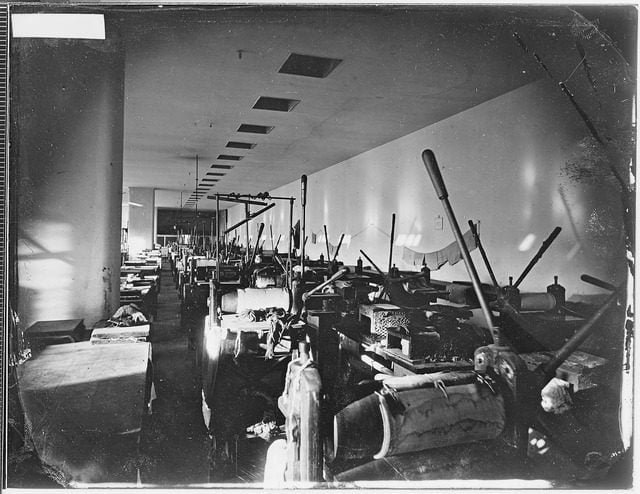The Evolution of Print Media: A Glimpse into Ancient Times
The evolution of print media can be traced back to ancient civilizations, where various forms of written communication were utilized. Ancient civilizations like Egypt and Mesopotamia recorded their histories, laws, and stories on clay tablets, papyrus[i], and stone inscriptions. Standardized communication marked a significant step forward with the invention of writing systems like hieroglyphics[ii] and cuneiform[iii].
The invention of paper in Han Dynasty China (about 105 CE) was a turning point in the development of the print media. While writers still had to transcribe documents manually, this innovation greatly facilitated the production of written materials. However, the innovations in printing technology in the later centuries truly revolutionized how information was disseminated.
The Gutenberg Revolution: Birth of the Printing Press
Johannes Gutenberg’s development of the printing press in 1440 was one of the most revolutionary events in the history of print media. The invention harnessed the power of moveable type, enabling the mass production of books and other printed goods. His Bible, printed in 1455, is regarded as the first significant book to be printed using this revolutionary technology. This breakthrough marked the beginning of the mass production of books, making disseminating knowledge more accessible and affordable.
The printing press significantly affected the growth of print media. It enabled the dissemination of knowledge and played a crucial part in the Renaissance, a time characterized by a renewed interest in the arts, sciences, and classical studies. With the emergence of printed books, education became more accessible to a larger portion of society, resulting in increased literacy rates and a shift in how people acquired knowledge.
The Era of Newspapers: Informing the Masses

As print technology continued to advance, newspapers emerged in the 17th century. The “Relation” was published in Strasbourg in 1605, followed by the “London Gazette” in 1665. These early newspapers were often published weekly or monthly, informing readers about current events, commerce, and politics.
In the 18th century, newspapers proliferated throughout Europe and the American colonies. These newspapers were indispensable to political debate and crucial in moulding public opinion. In the United States, publications such as Benjamin Franklin’s “The Pennsylvania Gazette” contributed to disseminating ideas that sparked the American Revolution.
Birth of Print Media in India

The history of print media in India began in the 16th century when European missionaries and merchants introduced printing technology. In 1556, the Portuguese created the first printing press in India in Goa to disseminate Christian literature. However, the turning point occurred in the early 18th century when Irishman James Augustus Hicky published “Hicky’s Bengal Gazette” in Calcutta (now Kolkata) in 1780. It is primarily regarded as India’s first newspaper, marking the beginning of Indian journalism.
Industrialization and the Mass Circulation Press
Significant advances in print technology occurred during the 19th century, coinciding with the rising industrialization of Western countries. Innovations such as steam-powered printing presses, mechanical typesetting, and the employment of high-speed machines changed the newspaper industry. This era witnessed the emergence of the mass circulation press, which was marked by daily publications and lower prices.
Due to their low pricing, penny newspapers, such as “The New York Sun” and “The Daily Mail” in the United States and the United Kingdom, made newspapers more accessible to the working class. This period also saw the birth of sensationalism in journalism, as newspapers battled for readership with attention-grabbing headlines and scandalous stories.
Early Growth and Struggles of Print Media in India
India’s print media expanded tremendously in the 19th century. During this time, the impact of newspapers such as “The Hindu” (formed in 1878) and “The Times of India” (started in 1838) began to take shape. These publications were crucial in shaping public opinion and establishing a spirit of nationalism.
During the colonial era, the Indian press was also subject to censorship and repression, as many legislation and laws tried to restrict press freedom. For instance, the Vernacular Press Act of 1878 sought to regulate regional-language journals. Despite this, Indian journalists and publications persisted in their efforts to inform and inspire the masses.
The Role of Print Media in the Independence Movement of India
Print media played a crucial part in India’s freedom struggle. Leaders such as Mahatma Gandhi and Jawaharlal Nehru utilized newspapers and magazines to promote their goals and rally public support. Gandhi’s “Harijan” and “Young India” were effective spokespersons for his nonviolent resistance movement.

Post-Independence Era
In 1947, when India gained independence, the print media scene witnessed a tremendous transformation. The Indian Constitution guaranteed freedom of the press, and this newfound liberty created a thriving and diverse media environment. The circulation of “The Times of India,” “The Indian Express,” and “Hindustan Times” increased significantly as they became influential voices in the Indian media landscape. Alongside English-language media, regional language newspapers began to develop, catering to India’s unique linguistic and cultural landscape. These publications include “Amar Ujala” (Hindi), “Anandabazar Patrika” (Bengali), and “Dainik Bhaskar” (Hindi).
Print Media in the 20th Century: Challenges and Innovations.
The 20th century was a century of contrasts for print media. On the one hand, it experienced extraordinary development and innovation, while on the other, it faced problems posed by evolving technology and competition from other media types.
The introduction of color printing and advancements in photojournalism expanded the visual attractiveness of newspapers and magazines. World War I and World War II highlighted the significance of print media as a news and information source. During this time, newspapers such as “The New York Times” and “The Times of London” gained international fame.
In the latter half of the 20th century, television and radio emerged as the primary forms of mass communication. Print media faced the challenge of adapting to these new mediums. Nonetheless, it found ways to innovate, introducing new forms such as tabloid newspapers and magazines catering to specific interests such as fashion, entertainment, and way of life.
The Digital Revolution: Navigating the Information Age

The digital revolution of the late 20th and early 21st centuries changed the print media landscape. The advent of the Internet and digital technology presented both benefits and obstacles. Online news websites and digital editions of newspapers and magazines allowed global distribution and real-time updates. However, the ease of internet publication has led to questions regarding the quality and accuracy of information.
Print media organizations had to adapt quickly to the digital age by developing online presences, embracing multimedia storytelling, and introducing paywalls and subscription structures to maintain revenue. Social media platforms have further transformed news dissemination, as information may be instantly and virally disseminated.
Indian Print Media in the Digital Age
The introduction of offset printing, the computerization of editing operations, and the use of satellite technology for news distribution enhanced the quality and effectiveness of print media in India.
However, the greatest dramatic development occurred in the 1990s with the introduction of the Internet. Newspapers and publications have embraced online media, expanding their global readership reach. The “The Times of India” website was created in 1997, followed by other major publications.

The Contemporary Landscape: Print Media Today
Print media has evolved into a multi-platform enterprise in the 21st century. Traditional newspapers and magazines continue to exist in print and digital modes, while independent journalism websites and new media channels have flourished. The accessibility of smartphones and tablets has increased the reach of print media by enabling readers to access content on the go.
In-depth reporting, investigative journalism, and lengthy narratives rely heavily on the printed word. Magazines like The New Yorker and National Geographic continue to prosper, giving readers in-depth analysis, photographs, and captivating storylines.
Print media remains a powerful and dynamic industry in India. Leading newspapers such as “The Times of India” and “The Indian Express” maintain a significant print and digital presence, appealing to a varied audience. Regional language newspapers have also adapted to the digital age, ensuring that news is available to speakers of various Indian languages.
Print media continues to be a critical source of news and information, particularly for those who prefer the tactile experience of reading a physical newspaper. In addition, the editorial standards and investigative journalism of Indian publications remain vital in holding those in power accountable.
Challenges and Controversies
From the first newspaper in the late 18th century to the digital transformation in the 21st century, Indian print media has been instrumental in informing, influencing, and reflecting the diverse voices of the nation. However, there have been concerns about the independence and integrity of the print media. Occasionally, paid journalism, sensationalism, and biased reporting have damaged the reputation of certain publications. Despite this, Indian print media has continued to provide the public with trustworthy, educational, and thought-provoking information.
Conclusion
The rise and development of print media are evidence of human brilliance, technological advancement, and the medium’s continuing relevance. From the earliest forms of written communication to the digital age, print media has adapted to shifting societal requirements and technological advances. It has been instrumental in changing societies, stimulating public dialogue, and sharing information.
Print media is an important component of mass communication and journalism in the information era. It coexists with digital platforms and provides a unique and useful perspective. In an ever-changing media world, its capacity to provide in-depth reporting, critical analysis, and long-form narratives maintains its sustained relevance.
[i] Papyrus is a tall, grass-like plant, used by the ancient Egyptians, Greeks, and Romans as a writing material.
[ii] Hieroglyphics is a form of writing that uses pictures or symbols to represent objects, concepts, or sounds. Hieroglyphics were used in ancient Egypt and other writing systems.
[iii] Cuneiform is an ancient writing system that was used in the Middle East. Cuneiform was first developed by the ancient Sumerians of Mesopotamia around 3500 BCE. It was used to record literature, such as the Epic of Gilgamesh, and to communicate and formalize legal systems, such as Hammurabi’s Code. Cuneiform was used until the 1st century BC.




